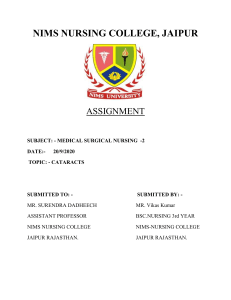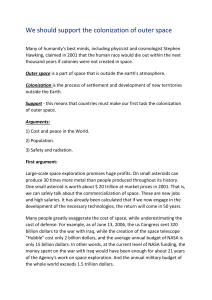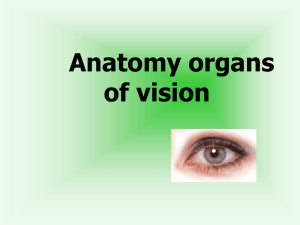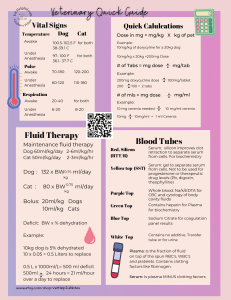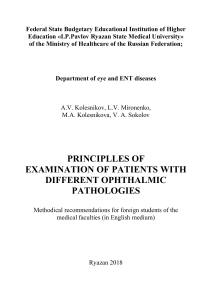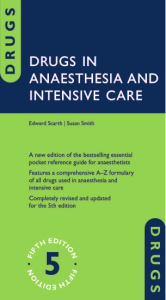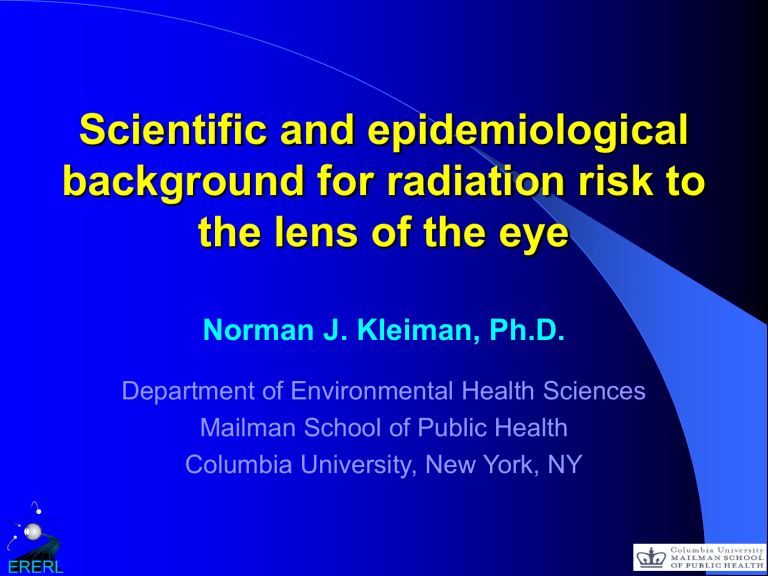
Scientific and epidemiological
background for radiation risk to
the lens of the eye
Norman J. Kleiman, Ph.D.
Department of Environmental Health Sciences
Mailman School of Public Health
Columbia University, New York, NY
Lens injury severity versus dose (cardiologists)
Lens opacity (relative scale)
2,5
y = 0,067x + 0,317
R² = 0,481
2
1,5
1
0,5
0
0,0
2,0
4,0
6,0
8,0
10,0
12,0
14,0
16,0
18,0
20,0
Cumulative dose during working years (Sv)
Eye Radiation and Environmental Research Laboratory
INTERNATIONAL COMMISSION ON RADIOLOGICAL PROTECTION
ICRP ref 4825-3093-1464
Statement on Tissue Reactions
Approved by the Commission on April 21, 2011
(1) The Commission issued new recommendations on radiological
protection in 2007 (ICRP, 2007), which formally replaced the
Commission’s 1990 Recommendations (ICRP, 1991a). The revised
recommendations included consideration of the detriment arising from noncancer effects of radiation on health. These effects, previously called
deterministic effects, are now referred to as tissue reactions because it is
increasingly recognised that some of these effects are not determined
solely at the time of irradiation but can be modified after radiation
exposure.
INTERNATIONAL COMMISSION ON RADIOLOGICAL PROTECTION
ICRP ref 4825-3093-1464
(2) The Commission has now reviewed recent epidemiological evidence
suggesting that there are some tissue reaction effects, particularly those
with very late manifestation, where threshold doses are or might be lower
than previously considered. For the lens of the eye, the threshold in
absorbed dose is now considered to be 0.5 Gy.
(3) For occupational exposure in planned exposure situations the
Commission now recommends an equivalent dose limit for the lens of the
eye of 20 mSv in a year, averaged over defined periods of 5 years, with no
single year exceeding 50 mSv.
Retrospective Evaluation of Lens Injuries and Dose: “RELID”
Interventional cardiologists
Chernobyl “Liquidators”
Residents of contaminated buildings
Infants treated for facial hemangiomas
Radiological technologists
A-bomb survivors
Astronauts
Anesthesiology 114, 512-520, 2011
CATARACT
A change in transparency of
the lens
Why study the lens?
Why do we still care about cataract?
Cataract and World Blindness
•
•
•
•
•
25 million blind people globally due to cataract
119 million individuals visually impaired by lens opacification
Cataract is still the leading cause of blindness in the 3rd world
Lens opacities can be found in 96% of all individuals older than 60 yrs
With an increasingly healthy, aging population, the societal and
economic burden of cataract surgery is expected to greatly increase
- Cataract surgery represents 12% of the U.S. Medicare budget and 60% of all Medicare
visual costs
WHO, 2002, Eye Diseases Research Prevalance Group, 2004
Hans Bethke
RADIATION CATARACT
a specific subset of lens opacities
Classical Radiation Cataract
A lens opacity most often originating near
the visual axis, first appearing in the
posterior subcapsular region of the lens
radiation cataract
(Scheimpflug image)
Why do we care about radiation
cataract?
Impact on workers
May be preventable
Canary in a coal mine?
The lens is one of the most
radiosensitive of all tissues
Radiation cataract provides a
model for studying long-term
biological effects following lowdose ionizing radiation
exposures in environmental or
occupational settings.
Potential visual disability and
morbidity resulting from radiation
cataract and/or its treatment is
greatly underappreciated.
Potential Low-Dose
Radiation Exposures
• Accidental
- Chernobyl, Fukushima, future??
- contaminated buildings (e.g. Taiwan)
- terrorism
• Occupational
- interventional physicians
- associated nurses and technicians
- nuclear medicine personnel
- nuclear plant workers
- industrial workers
- astronauts
- uranium miners
• Medical
- Diagnostic procedures
- Therapeutic treatments
• Environmental
- indoor radon
- geography (Denver, USA; Kerala, India; Ramsar, Iran)
Occupational exposure to the lens
increasing usage
Radiologists
Cardiologists
Gastroenterologists
Orthopedists
Urologists
Vascular medicine
Neurologists
Anesthesiologists
Nurses and technicians
Other workers
…limited study
How much exposure?
• 17 million interventional fluoroscopic
procedures (USA) (NCRP-2009)
- 4.6 million cardiac
- 3.4 million vascular
- 8.6 million non-vascular
• 8.6% annual increases
Health Physics 103: 80-99, 2012
Interventional Medicine
0.25 – 2.5 mSv/h
0.5- 5 mSv/h
1- 10 mSv/h
- Is there new data on human radiation cataract risk? Are
proposed new eye dose limits appropriate?
- What is the relevance of radiation cataract to human
radiobiology?
-Can we utilize radiation cataract as a “biomarker” of
radiation exposure?
-Can we model radiation sensitivity and /or population
heterogeneity effects using this approach
-i.e., can we identify specific genes that confer sensitivity or
resistance to radiation cataract?
- Can we find alternative methodologies for quantitating
lens opacities for that better estimate any visual
disability caused by radiation exposure?
Additional data regarding the
dose threshold, if any, for visual
disability is essential for better
occupational risk assessment
and further refinement of
suggested exposure guidelines.
Prior to 2012, eye exposure guidelines
were based on the view that radiation
cataract is a “deterministic” event with a
relatively high threshold radiation dose
INTERNATIONAL COMMISSION ON RADIOLOGICAL PROTECTION
ICRP ref 4825-3093-1464
(2) The Commission has now reviewed recent epidemiological evidence
suggesting that there are some tissue reaction effects, particularly those
with very late manifestation, where threshold doses are or might be lower
than previously considered. For the lens of the eye, the threshold in
absorbed dose is now considered to be 0.5 Gy.
(3) For occupational exposure in planned exposure situations the
Commission now recommends an equivalent dose limit for the lens of the
eye of 20 mSv in a year, averaged over defined periods of 5 years, with no
single year exceeding 50 mSv.
Establishing an accurate dose
threshold, if any, for radiation
cataractogenesis is critical for
risk assessment and exposure
guidelines.
How did we derive the
guidelines for lens
exposure limits?
Early Radiation Cataract Studies
“Ophthalmological survey of atomic bomb survivors in Japan in 1949”
Trans. Am. Ophthalmol. Soc. 48, 1950
“Cyclotron-induced radiation cataracts” Science 110, 1949
•
•
•
•
•
•
•
Chalupecky, 1897
Rohrschneider, 1932
Hiroshima, Nagasaki, 1945
Cyclotron , 1940’s
Poppe, Cogan, 1950’s
Merriam & Focht, 1957, 1962
Merriam & Worgul, 1976
Early Radiation Cataract Studies
• Important historical studies that helped define the
nature of radiation cataract and establish initial
guidelines for safe exposures to the lens.
• Failed to take into account increasing latency period
as dose decreases.
• Did not have sufficient sensitivity to detect early lens
changes.
• Relatively few subjects with doses below a few Gy.
Historical
Threshold Estimates (Sv)
threshold dose
5 - 15
2 - 5.5
0.7 - 1.4
0.4 – 0.7
reference
anecdotal, pre-1950
Merriam and Focht, 1957
Otake, 1982
Worgul, 2007
# subjects
100
276
2,124
8,600
Additional data regarding the
dose threshold, if any, for visual
disability is essential for better
occupational and environmental
risk assessment and further
refinement of suggested
exposure guidelines.
The lens
Three things to remember
about the lens
The lens grows throughout life
The source of that growth is a proliferating
subset of the anterior epithelial cell monolayer
Transparency is dependent on proper division
and differentiation of the progeny of this
proliferative population
Radiation Cataract
Pathomechanism
Genotoxic damage to the lens epithelium
Lens shielding studies
Mitotic inhibition studies
Irradiation of posterior 2/3 lens
IONIZING RADIATION
....
...
.
Damage to Lens Epithelial DNA
[ dividing cells ]
[ differentiating cells]
Abnormal Lens Fibers
Loss of Transparancy
CATARACT
ANIMAL STUDIES
Irradiation of the mouse lens by 500 mGy X-ray
(Contralateral eye shielded)
normal
irradiated
Transparency is dependent on proper differentiation of
maturing lens fiber cells
X-ray
X
X
X-ray
X-ray
X-ray
The radiation target is a small proliferating subset of the lens epithelial population
MR
GZ MR
GZ
TZ
CZ
TZ
PREVALANCE (1.0 Cataract )
Fully Exposed Lens.
1
Partially Exposed Portion of Lens
Fully Shielded Lens
0.8
Partially Shielded Portion of Lens.
0.6
100 mGy Exposure
0.4
0.2
0
24
28
32
36
40
44
48
52
56
TIME (weeks)
Invest. Ophthalmol. Vis. Sci. 46, 2005
60
64
1.0
0.5 Gy
0.9
Cataract prevalence
Cataract grade: 1.0
0.8
ATM
Homozygote
0.7
0.6
ATM Heterozygote
0.5
0.4
0.3
0.2
Wildtype
0.1
0.0
0
10
20
30
40
50
Time after irradiation (weeks)
Rad Environ Biophys 45, 2006
60
70
Cataract Prevalence
1.0
0.8
0.6
RAD9+/-, ATM+/RAD9+/-, ATM+/+
RAD9+/+, ATM+/RAD9+/+, ATM+/+
0.4
0.2
Cataract grade: 1.0
0.0
15
20
25
30
35
40
45
50
55
Time after irradiation (weeks)
Radiat. Res 168, 2007
HUMAN STUDIES
More recent studies of occupational risk:
Epidemiological findings
More recent studies are consistent with a
very low or even zero threshold model for
radiation cataract
Diagnostic procedures
Klein, 1993
Radiotherapy
Wilde, 1997
Hall, 1999
Astronaut core
Cucinotta, 2001
Rastegar, 2002
Atomic bomb survivors
Nakashima, 2006
Neriishi, 2007, 2012
Contaminated buildings
Chen, 2001
Chernobyl
Day, 1995
Worgul, 2007
Occupational Risk
Worgul, 2004
Chodick, 2008
B.V. Worgul, Z.J. Haskal and A.K. Junk (2004)
RSNA News 14, 5-6, 2004
• Pilot study involving eye exams of 59 interventional radiologists
29-62 years old
• Frequency and severity of posterior subcapsular cataract increased
with age and years in practice
• Nearly half of those examined had early lens changes associated with
radiation cataract
• 5/59 had clinically significant posterior subcapsular cataracts (psc)
•22/59 had posterior dots and vacuoles characteristic of early psc
development
Cataracts among Chernobyl clean-up worker:
Implications regarding permissible eye exposures
B.V. Worgul, Y.I. Kundiyev, N.M. Sergiyenko, V.V. Chumak, P.M. Vitte,
C.P Medvedovsky, E.V. Bakhanova, A.K. Junk, O.Y. Kyrychenko, N.V.
Musijachencko, S.A. Shylo, O.P. Vitte, S. Xu, X. Xue and R.E. Shore
Radiat. Res. 167, 233-243 (2007)
The Ukrainian American Chernobyl Ocular Study
(UACOS)
Adjusted Odds Ratios for Cataract Outcome Variables (Incidence Data) Among the
Chernobyl Liquidators
5
4.5
4
3.5
3
OR 2.5
2
1.5
1
0.5
0
0-49
50-99
100-199
200-399
400-699
700+
Dose Group, mSv
Polychromatic Sheen
Early pre-cataract changes
Stage 1-5 cataract
Stage 1 cataract
Stage 1-5, excluding nuclear cataracts
Stage 1, excluding nuclear cataracts
Neriishi, Nakashima, et al. (2007) Postoperative
cataract cases among atomic bomb survivors: radiation
dose response and threshold. Rad Res 168:404-408.
Neriishi, Nakashima, et al. (2012) Radiation dose and
cataract surgery incidence in atomic bomb survivors,
1986-2005. Radiology 265:167-174.
first documentation of clinically relevant visual disability
(cataract extraction) following low dose exposure
threshold dose estimate of 0.45 Gy
95% confidence interval of 0.1-1.0Gy
At the time of the study (2005), the youngest survivors were only
57 years old, suggesting that additional cases may occur in future
years.
Risk of Cataract after Exposure to Low
Doses of Ionizing Radiation: A 20-Year
Prospective Cohort Study among US
Radiologic Technologists
G. Chodick, N. Bekiroglu, M. Hauptmann, B.H. Alexander,
D.M. Freedman, M.M. Doody, L.C. Cheung, S.L. Simon,
R.M. Weinstock, A. Bouville and A.J. Sigurdson
Am. J. Epidemiol. 168, 620-631 (2008)
- long term, prospective analysis of self-reported cataract
diagnosis in 35,700 individuals 22-44 years old at study onset
• adjusted cataract hazard ratio of 1.18 for those in the
highest exposure range (60 mGy) as compared to those
in the lowest (5 mGy)
• the median occupational ionizing radiation dose to the
lens was estimated to be 28.1 mGy for the entire cohort
RELID
Retrospective Evaluation of Lens Injuries and Dose
• Conducted at regional meetings of cardiologists and medical workers
in Bogotá, Colombia, Montevideo, Uruguay, Bulgaria and Malaysia.
• Detailed questionnaire about medical, ocular and occupational history
• Dilated, comprehensive slit lamp of the lens
• Correlate occupational radiation exposure with radiation cataract risk
J Vasc Interv Radiol 24:197-204, 2013
Prevalence
Subjects (n)
Posterior subcapsular
opacities in one or both
eyes
P value
Interventional cardiologists (58)
22 (37.9%)
< 0.005
Nurses and technicians (58)
12 (20.7%)
0.13
Unexposed controls (93)
11 (11.8%)
Subject characteristics and prevalence of posterior lens changes in
interventional cardiologists, nurses and technicians (Bogotá/Montivideo cohort
Subjects
Mean age
(yrs)
Range (yrs)
Mean
working time
(yrs)
Cumulative
occupational
lens dose (Sv)
Range (Sv)
Interventional
Cardiologists
46 ± 8
30-69
14 ± 8
6.0 ± 6.6
0.1-27
Nurses and
Technicians
38 ± 7
22-60
7±5
1.5 ± 1.4
0.2-4.5
Controls
41±10
20-66
n/a
n/a
Vano, Rad Res 174:490-495, 2010
Dose Response
Dose (Sv)
Number of
subjects
Number of subjects with
posterior lens changes*
OR
95% CI
0 (Control)
22
2 (9%)
1.0
n/a
0.5-1
8
2 (25%)
3.8
0.36-39
1-2
11
5 (45%)
8.2
1.4-47
2-3
9
5 (55%)
13
2.1-81
>3
16
12 (75%)
16
4.2-58
Total: 67
34 (51%)
5.4
2.0-14
*Grade 0.5 or higher in either eye
The number of interventional cardiology workers (cardiologists or nurses) with posterior
lens changes characteristic of ionizing radiation exposure as a function of total cumulative
ocular occupational exposure. (Malaysian cohort)
Ciraj-Bjelac, Cathet Cardio Interv 76:826-834,2010
• Most cardiologists with early lens changes
reported never or infrequently utilizing eye
protection
• Frequency and severity of posterior lens
changes increase with age and years in
practice
Internat J Cardiol 167:1843-1847, 2013
The rate of progression of such radiation associated
lens changes is slow.
Nevertheless, eye protection is recommended to delay progression
and limit future cumulative dose to the lens.
These new studies provide additional
support for the hypothesis that the
threshold radiation cataract dose in
human populations may be
significantly lower than currently
accepted.
Additional studies, for example in
other interventional physician cohorts
and associated medical workers, may
help further refine appropriate risk
guidelines and the radiation cataract
“threshold” for occupational
exposure
Future Interventional Medicine
Studies
•
•
•
•
•
•
•
•
Large cohort size
Broad representation age, gender, procedure
Well documented exposure history
Appropriate controls (eg; SocioEconomicStatus)
Real –time eye dose measurements
Careful dilated slit lamp exam
Contrast Sensitivity Testing
Long-term follow-up to study progression rate
Potential visual disability and
morbidity resulting from radiation
cataract and/or its treatment is
underappreciated.
Potential surgical/post-surgical
complications of cataract extraction
•
•
•
•
•
•
•
•
•
•
Endophthalmitis
Uveitis
Hyphema
Corneal edema
Choroidal hemmorrhage
Lens dislocation
Rupture of the posterior capsule
Retinal detachment
Glaucoma
Posterior subcapsular opacification
Potential post-operative visual
complications of cataract surgery
•
•
•
•
•
Glare and flare
Decreased acuity
Decreased contrast sensitivity
Photophobia
Stereopsis
Cataract surgery risk estimates
• Posterior Sub-Capsular Opacification
• 10%
• Cystoid Macular Edema
• 1-10%
• Retinal Detachment
• 0.5%
• Permanent Vision Loss
• 0.1%
• Death
• 0.01%
HEALTH PHYSICS SOCIETY
Comments on ANPR, 10 CFR 20
November 10, 2014
Docket ID No. NRC-2009-0279
Issue 2: Occupational Dose Limit for the Lens of the Eye
Q2–2: How should the impact of a radiation-induced cataract be viewed in
comparison with other potential radiation effects?
Response: The Society wishes to bring the following information to the attention of the Commission:
“…available data suggests mortality following cataract surgery is on the order of 0.1%, and that morbidity, defined both from an
ophthalmological as well as medical standpoint, is consider-ably higher. Of equal import, prior to a documented clinical need for
cataract surgery, there may be accompanying progressive decreases in visual acuity, contrast sensitivity and visual function that
may negatively impact worker performance”
“In conclusion, the combined morbidity and mortality risks of
surgical correction of radiation-induced cataracts (1% or more)
and the, as yet unquantified, risk of a physician misdiagnosing or
mistreating a patient because of loss of visual acuity due to the
presence of an undiagnosed cataract, greatly outweighs the risk
of cancer in affected individuals. “
Basil V. Worgul, Ph.D. , 1947-2006
Professor of Radiation Biology
Departments of Ophthalmology and Radiology
Columbia University

